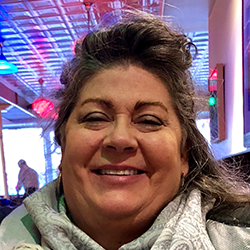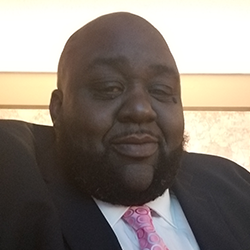Resident Perspectives
Mar 23, 2018
 Adrianna O’Neill
Adrianna O’Neill
Decisions are shaped by those who show up!
A resident perspective by Adrianna O’Neill,
Resident Advisory Board Member, Public Housing Authority of Truth or Consequences, New Mexico
Last year the public housing authority (PHA) where I live began a series of meetings to inform residents of the new HUD Smoke-Free Housing policy that becomes effective on July 31, 2018. I attended the first of these meetings along with many of my neighbors and fellow residents—including both smokers and non-smokers alike. Many of the smokers in attendance were upset at the idea that soon they might have to leave their homes and be at least 25 feet away from any of the buildings on our property to smoke. The PHA offered assistance for smoking residents in the form of classes and information to reduce or stop smoking, but many of us wanted more from the PHA.
Personally, I felt conflicted in thinking about this new policy. I want a healthier living environment for myself and my neighbors—one that limits our exposure to secondhand smoke. At the same time, though, I know that smoking is a very challenging addiction to beat, and I want to make sure that we care for our neighbors who smoke as we implement this new policy. I volunteered to join the Resident Advisory Board (RAB) to assist in this transition to smoke-free housing. Our RAB brought together a diversity of residents—adults, children, elders, people with physical and intellectual disabilities, long-time residents, and newcomers to our community. We shared many hours together discussing ideas, reading research on the topic, and interviewing experts. All our time together was dedicated to working with the PHA to assist in improving the health and wellbeing of all residents in our community.
Our final requests to the PHA consisted of three important points that we wanted to guarantee. We asked that the PHA establish safe Designated Smoking Areas for smokers in our community that shelter us from the outdoor elements, especially the overnight winter cold, harsh winds, monsoon rains, and intense summer heat that are a common feature of life in the New Mexico desert lands. We requested that the PHA assist residents who smoke, and who would like to quit or cut back on their smoking, in obtaining educational resources and smoking cessation products, such as nicotine lozenges, patches, and gum.
Based on our research, we now know much more about the dangers of secondhand smoke. We determined that there really were no advantages to delaying implementation of our PHA’s smoke-free housing policy, so we asked that the PHA fully implement its new policy as soon as legally possible. We also supplied the PHA with a report that outlined where the Designated Smoking Areas should be located, to be convenient for smokers in our community, and still serve the intentions of smoke-free housing.
I don’t know what my PHA’s implementation of smoke-free housing would look like if none of us residents decided to get involved, but I’m glad I joined the Resident Advisory Board to participate in this effort. This was beneficial to all of us who participated—residents, RAB members, and staff of the PHA. The Resident Advisory Board will remain together and continue meeting until the smoke-free policy has been fully implemented. We look forward to a fair transition and making a positive impact in our community.
Yours In Advocacy,
Adrianna
 Danny Barber
Danny Barber
NYCHA Residents Take A Stand
A resident perspective by Danny Barber, Chairperson for the City-wide Council of Presidents, New York
On Tuesday February 27th, the duly elected representatives of New York City Housing Authority’s (NYCHA’s) residents, best known as The City-wide Council of Presidents (CCOP), filed a historic lawsuit as co-plaintiffs against NYCHA.
CCOP, along with At-Risk Community Services, a not-for-profit which provides legal and accounting services to CCOP, filed an Article 78 suit against the Authority for a host of issues. It marked the first time in history the residents of NYCHA have filed such a suit.
The issues in the suit included NYCHA’s failures regarding lead paint, Section 3 and Section 964. The residents have asserted that their living conditions have become intolerable due to NYCHA’s mismanagement. The suit was announced by the plaintiff’s attorneys at a fierce rally on the steps of City Hall. As the Chairperson of CCOP, I used the announcement as a chance to passionately describe the challenging state of affairs at NYCHA, including children with high levels of lead poisoning in their blood and many other examples of poor living conditions.
Our lawsuit has several objectives. First and foremost, the suit is meant to have the courts impose monitors on NYCHA to make sure that they comply with the law. It has become clear that NYCHA is incapable of policing itself.
A second purpose of our suit is to fire a warning shot at the politicians, including a seemingly powerless city council, as well as Mayor Bill de Blasio. The residents are no longer going to rely on the politicians for help. We are going to drive our own fate.
I am hoping the lawsuit is also a call to action. One purpose of this action is to galvanize the resident leadership to finally stand together. NYCHA has over four hundred thousand residents. Together, we make up a gigantic voting block in New York City. It is our job to come together and to make our voices heard. I am currently working with At-Risk to develop their “Get registered – Get out to vote” campaign which will attempt to register every eligible NYCHA resident and work toward electing public officials who want to help the residents.
In solidarity,
Danny Barber
WE WANT TO HEAR FROM YOU!
Submit your feedback about this edition of Tenant Talk, stories about events in your community, or reflections on federal policy to [email protected], and you could be featured in future editions of Tenant Talk!